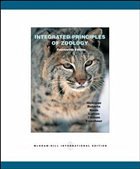Emphasizing the principles of evolution and zoological science, this best-selling text describes the diversity of animal life and the fascinating adaptations that enable animals to inhabit so many ecological niches. Featuring high quality illustrations and photographs and an engaging narrative, Integrated Principles of Zoology is considered the standard by which other texts are measured. With its traditional organization and comprehensive coverage, this text is suitable for one- or two-semester introductory courses in zoology.
Table of contents:
Part 1 Introduction to Living Animals
1 Life: Biological Principles and the Science of Zoology
2 The Origin and Chemistry of Life
3 Cells as Units of Life
4 Cellular Metabolism
Part 2 Continuity and Evolution of Animal Life
5 Genetics: A Review
6 Organic Evolution
7 The Reproductive Process
8 Principles of Development
Part 3 Diversity of Animal Life
9 Architectural Pattern of an Animal
10 Classification and Phylogeny of Animals
11 Protozoan Groups
12 Sponges and Placozoans
13 Radiate Animals
14 Flatworms, Mesozoans, and Ribbonworms
15 Gnathiferans and Smaller Lophotrochozoans
16 Molluscs
17 Annelids and Allied Taxa
18 Smaller Ecdysozoans
19 Trilobites, Chelicerates, and Myriapods
20 Crustaceans
21 Hexapods
22 Chaetognaths, Echinoderms, and Hemichordates
23 Chordates
24 Fishes
25 Early Tetrapods and Modern Amphibians
26 Amniote Origins and Nonavian Reptiles
28 Mammals
Part 4 Activity of Life
29 Support, Protection, and Movement
30 Homeostasis
31 Internal Fluids and Respiration
32 Digestion and Nutrition
33 Nervous Coordination
34 Chemical Coordination
35 Immunity
36 Animal Behavior
Part 5 Animals and Their Environments
37 The Biosphere and Animal Distribution
38 Animal Ecology
Glossary
Credits
Index
Table of contents:
Part 1 Introduction to Living Animals
1 Life: Biological Principles and the Science of Zoology
2 The Origin and Chemistry of Life
3 Cells as Units of Life
4 Cellular Metabolism
Part 2 Continuity and Evolution of Animal Life
5 Genetics: A Review
6 Organic Evolution
7 The Reproductive Process
8 Principles of Development
Part 3 Diversity of Animal Life
9 Architectural Pattern of an Animal
10 Classification and Phylogeny of Animals
11 Protozoan Groups
12 Sponges and Placozoans
13 Radiate Animals
14 Flatworms, Mesozoans, and Ribbonworms
15 Gnathiferans and Smaller Lophotrochozoans
16 Molluscs
17 Annelids and Allied Taxa
18 Smaller Ecdysozoans
19 Trilobites, Chelicerates, and Myriapods
20 Crustaceans
21 Hexapods
22 Chaetognaths, Echinoderms, and Hemichordates
23 Chordates
24 Fishes
25 Early Tetrapods and Modern Amphibians
26 Amniote Origins and Nonavian Reptiles
28 Mammals
Part 4 Activity of Life
29 Support, Protection, and Movement
30 Homeostasis
31 Internal Fluids and Respiration
32 Digestion and Nutrition
33 Nervous Coordination
34 Chemical Coordination
35 Immunity
36 Animal Behavior
Part 5 Animals and Their Environments
37 The Biosphere and Animal Distribution
38 Animal Ecology
Glossary
Credits
Index

